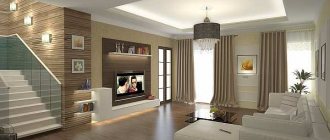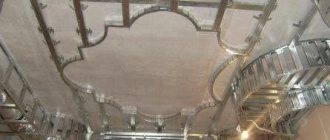What was the height of the ceilings in a house made of panel slabs in Soviet times? And at the very beginning of panel construction, and at the end of the era of developed socialism? At what height of rooms are houses built according to modern designs? Let's take a brief excursion into the past and present of housing construction.
How has the height of panel ceilings changed over the last half century? Let's find out.
Standard ceiling heights
The main regulatory document regulating the height of ceilings in apartment buildings is SNiP 31-01-2003, according to which the parameter in question depends on:
- Climatic conditions in a particular area;
- Purpose and type of room.
Climatic region is a parameter that takes into account the average temperature profile for each month, as well as the level of humidity and wind direction. According to SNiP 01/23/99, there are four districts divided into 16 zones. The zones are arranged in descending order - the higher the category, the milder the climate in this zone.
According to the standard, in the warmest zones the ceiling must be at a height of at least 2.7 meters, and for other areas the minimum ceiling height is 2.5 meters. These parameters are not formed out of the blue - complex calculations show that ensuring a normal microclimate and air exchange in rooms is possible only if the actual parameters correspond to the nominal ones.
In rooms located in the attic, the ceiling can be lowered, but the amount of reduction is also regulated - the ceiling level can deviate from the standards only over half the area of the room. In passage rooms (for example, corridors), the ceiling height according to GOST can be reduced to 2.1 m - this figure will be quite sufficient for the normal movement of people.
The maximum ceiling height is not specified by regulatory documents, but in practice the ceiling is rarely raised above 3.2 meters. In older buildings, the size of the rooms can be increased, as a result of which the ceiling height can exceed 4 meters.
When arranging your home yourself, you need to choose the ceiling height taking into account the parameters described above and the area of the premises. For example, for small and narrow rooms it is not recommended to use high ceilings - they will create a rather unpleasant feeling. In large rooms, this rule works in the opposite direction - for a large hall, a ceiling over 3 meters high is optimal.
Low ceilings: pros and cons
When choosing the height of ceilings in a private house, owners usually start from the area of the house and the main rooms. Such a landmark allows you to set harmonious proportions and give your home an attractive appearance.
In certain cases (for example, on the second floor), the height is reduced, which allows saving the construction budget and reducing utility bills. However, such savings are not always justified, since they are accompanied by the following disadvantages:
- In the bedroom, the feeling of oppressive space may not be felt, since its owners will spend most of their time lying down. A nursery or an office is another matter: it may turn out that the space will turn out to be extremely uncomfortable.
- Many solutions will become unavailable. It is unlikely that you will be able to decorate a low room with an elegant multi-tiered chandelier or decorative beams, or install a tension or hanging structure.
Economical living room option Source ruangarsitek.id
- A spacious, low room looks unpresentable, and it is almost impossible to fix. When decorating, there will be many restrictions in the choice of color, style, decorative items, furniture; the light from incorrectly selected lamps will hit the eyes.
"Stalin" and older houses
Older buildings traditionally did not skimp on space, so the area and height of each individual room was quite large. The thing is that the historical period in which such houses were built was not characterized by the desire to provide all families with at least a small apartment.
The ceiling height standards in "Stalinka" buildings vary from 3.3 to 3.6 m, while the ceilings themselves are usually decorated with various decorative elements - for example, stucco molding or cornices. When installing suspended ceilings in such apartments, due to the large amount of finishing, it is necessary to significantly reduce their level.
Certain difficulties also arise due to the fact that wooden elements were often used to make floors in old houses, and the wiring was laid externally - repairing the ceiling in such conditions is not very easy, so you have to invest much more money in repairs.
However, an increased amount of free space has its advantages - in a tall room with a large area, you can arrange any style, and it will look quite appropriate. An excellent option, for example, would be a multi-level suspended ceiling, decorated with a variety of decorative elements.
Suspended ceilings of any configuration are generally very suitable for rooms with a high ceiling height - the availability of space allows you to painlessly reduce the volume of the room. Finishing the very basic ceiling in such rooms would be a bad decision - the existing ceilings usually have a lot of “congenital” defects, which are very difficult to hide.
Foundation and roof
The height is 27 meters lower than the real one, the reason is due to unaccounted values. The house is not built directly from the ground, it stands on a foundation that has some elevation from the ground level. Residential floors come after the basement. The ground floor of a house is a room that is partially located in the ground; in high-rise buildings it is usually a basement.
Entrance to the ground floor
The foundation is quite a massive structure and must withstand the weight of 9 floors, which can be 15–18 thousand tons (one entrance). But it is almost all hidden underground and is not taken into account.
The roof is a complex technical structure
This is another plus meter to the resulting result, in total it is already 28 meters. A technical floor or roof can be added to this result, approximately 2.0 meters. In some buildings, instead of a technical floor, the elevator lifting mechanism was installed on the roof, and then the height of its cut will be indicated on the project.
"Khrushchev"
During the reign of Khrushchev, serious changes occurred in the construction industry. Thus, the main task set for the developers was to provide all families with their own housing. Of course, with such introductory housing, it was necessary to seriously reduce the housing, and the result of the design work was the “Khrushchev” - apartments with a very modest area and minimal ceiling height.
In classical apartments of the period under review, the ceiling was 2.5 m from the floor level. Individual apartments located on the first or last floor could have ceilings 0.1 m higher than the designated indicator. In the northern regions, the height from floor to ceiling in an apartment could reach 2.7 m.
For the manufacture of interfloor ceilings in Khrushchev-era buildings, reinforced concrete panels were used, which are easy to construct, quite reliable in operation and can be faced without problems. Accordingly, finishing ceilings usually came down to processing the joints in the slabs and applying whitewash.
Stretch ceilings, despite the reduction in ceiling height (even the simplest structures “eat up” about 5 cm), are used quite often in Khrushchev-era buildings. Lath or plasterboard structures are much less common - they require much more space to install. There is no need to talk about multi-level structures - they are completely inappropriate in such conditions.
By installing a suspended ceiling, you can try to compensate for the loss of free space by visually expanding the room. To achieve this effect, you need to very wisely select the colors and texture of the ceiling structure. It is better to use spotlights as lighting devices - installing large chandeliers in Khrushchev buildings is completely impractical.
Savings in the economy
During the Soviet era, much was standardized. Standards appeared based on standards, which were determined by calculations and tests. At the same time, projects for different regions differed. Soil and climatic conditions were taken into account and, most importantly, to build as economically as possible. The main task during the USSR was to provide people with housing, and convenience and comfort were in the background.
Savings explained a lot. The priority in the construction of 5 and 9-story buildings erected at that time is explained by simple reasons. A house with a height of more than 28 m had to be equipped with smoke-free stairs with a passage through an open balcony. Due to compliance with fire safety regulations, the installation of gas stoves is allowed only up to the 9th floor.
And besides, in addition to the elevator, which should have been equipped with nine-story buildings, as opposed to 5, 10-story buildings and above, they should have had a freight elevator. The cost of housing in such houses increases greatly and only pays off when constructing buildings of more than 14 floors.
Another reason for the popularity of the construction of 9-story buildings is that fire engines had standard stairs with a reach of up to 30 m. At that time, they used imported mechanized stairs “Magirus” or “Metz” installed on ZIS-6 (PEL-30).
30-meter ladder on a ZiS-6 chassis
"Brezhnevki"
After some time, when Brezhnev came to power, along with him came the desire of people to live in more comfortable conditions. This desire is reflected in state building regulations. Thus, the standard ceiling height in an apartment has increased to 2.6-2.7 m, and the rooms themselves have become larger. In addition, standard designs were supplemented with separate hallways, as well as built-in wardrobes and mezzanines. There were no other differences from the apartments of the Khrushchev era - all the same brick walls, panel ceilings, simplified layout and complete absence of any decoration.
Brezhnevkas are quite convenient in terms of repair. The ceilings in such apartments are simple and fairly flat, which allows you to use any available materials and solutions for finishing. The difference between the base ceiling and the minimum possible is about 15 cm - and this distance is quite enough for both simple finishing and for arranging suspended structures.
When you're not happy with the height
Sometimes it is necessary to change the height of the ceilings in an already finished house, and for this they use different techniques. In order to make the room a little more squat, the following methods are suitable:
- Suspended and tensile structures are still relevant. The design can be anything: multi-tiered, illuminated, with the interior trimmed with wood or other contrasting material.
- The ceiling can be turned into an accent surface, made bright, or vice versa, dark, contrasting with the rest of the interior. The easiest way is to use paint or wallpaper.
Beams make a room more comfortable Source initial.com.ua
Buildings made of panels and blocks
Initially, panel houses were built under Khrushchev. The standard configuration of such houses assumed that they would have five floors, and they would be built in the southern regions. The standard ceiling height in panel houses was about 2.5 meters, and the walls were built of brick. By and large, these buildings were very similar to typical “Khrushchev” buildings - there was little free space, and there was not enough natural light even on sunny days.
Renovation of houses made of panels and blocks occurred already in the 80s. The new buildings were distinguished by an increased number of floors, large area of premises and high ceilings - their minimum height was 2.65 m, and in some cases reached 2.75 m. Even with a superficial examination, we can safely say that such apartments were much more convenient.
This convenience was evident not only during the operation of the apartments, but also during renovations. Thus, finishing the ceiling was extremely simple - initially the surface of the floors was flat, so it could be arranged in any way. The high ceilings typical of such apartments made it possible to use suspended and suspended ceiling structures.
The most noticeable disadvantage of panel houses is the low level of sound and noise insulation. That is why during renovations it is always necessary to use high-quality materials to reduce the noise level entering the apartment from the outside.
How many meters high is a 9-story house: ceilings in a panel building
The height of a 9-story building in meters is a relative value that depends on which series of residential buildings this building belongs to. The construction of residential buildings in certain periods was carried out according to standard designs, and they had some differences in layout, floor height, and number of sections. Therefore, to determine the exact parameters and reliable information about the height of a nine-story building, it is necessary to have specific technical information. If an average height is needed, it is called 27 to 30 meters. Sometimes, to answer the question of how many meters are in a 9-story building, you need to take into account the roof, ground floor and additional architectural decorations.
Modern apartments
Today, apartments and premises in multi-storey buildings have a variety of layouts, and modern technologies are used in the construction process. Due to this, a fairly wide variability in the dimensions of the premises is ensured - for example, the height of the ceilings in the office can completely “float” depending on the purpose of a particular room. Diversity allows you to choose apartments in a wide range of prices - with a minimum budget you will have to choose among economy-class apartments, and the ability to invest more money allows you to purchase housing that will have a larger area and a high degree of comfort.
The difference between cheap and expensive apartments is obvious:
- When building small apartments and studios, the priority goal is the minimum cost of finished housing. One of the ways to save on materials is to limit the height of the ceiling, so the standard ceiling height in new buildings is usually the minimum allowable 2.7 m. The ceiling itself in such conditions lends itself to any finishing work - the only limitation is multi-level suspended structures, which are undesirable to install in small rooms . The optimal solution would be to use finishing materials that allow you to visually expand the space.
- For the construction of expensive apartments, individual projects are usually used, and the ceiling height in new buildings can vary from 2.8 to 3.2 m. The purchase of luxury housing usually indicates the good financial capabilities of the buyer, so all repair and finishing work in this case is entrusted to the appropriate specialists. A competent designer will calculate the optimal ceiling height for a specific project, which will fit perfectly into the planned style.
A little about the history of the issue
The design of houses of various heights is dictated by the need to save space, which arises in conditions of total urbanization.
The higher the house, the more apartments can be built in it and the more families can be accommodated.
Sample plan for a 9-story building
The expansion of large cities and megalopolises in width leads to the seizure of areas that could serve as agricultural land. Therefore, there was an urgent need for the design and construction of multi-storey buildings. Here are some examples:
- the first 4-story frame-panel house in the Soviet state was built in Moscow in the post-war period (1948);
- at the same time and a little later in Moscow, a residential area was built up with houses of 10 floors;
- the first frameless panel house, 7 floors high, was built in 1954, also in the capital;
- the construction of 5-story buildings was chosen for reasons of economy - this is the maximum number of storeys that allows construction without an elevator;
- For the first time, the construction of a 9-story panel house began in 1960.
Without an agreed project with all parameters, it is impossible to start construction
You can determine with accuracy how tall a 9-story building is using the standard code that was used to designate standard projects in the USSR. The index indicated the type of building and wall material (panels, load-bearing frame, blocks, bricks, etc.), series number and serial number of the project. Sometimes there are two more numbers, 1 or 2, indicating the period when it was adjusted.
Private houses
In the case of private houses, everything is somewhat different than with apartments. When building apartment buildings, developers have to take into account the fact that there will be many apartments in one building, and each of them needs to be made quite comfortable - i.e. certain restrictions are introduced. For private houses, such restrictions are irrelevant - the dimensions of the premises are practically independent of external factors.
For a comfortable stay in a private house, you need to raise the ceiling to a level of about 2.9-3.2 m. Of course, these figures can be increased even more, but this is impractical - the free space will not be in demand, and heating costs due to the increase the volume of the room will increase. In warm regions, this point can be ignored, but for the middle zone and northern regions it is more than relevant.
The selection of finishing materials for the ceiling directly depends on how the floors were formed:
- In the case of wooden beams, tensile and suspended structures are best, as well as wood cladding and materials that allow the beams to remain visible;
- Absolutely all finishing materials are suitable for reinforced concrete floors.
How many meters high is a 9 storey building?
What is the height of a 9-story building in meters can be easily calculated using the formula. It is enough to substitute the values of the height of the 1st floor and their number. The result should be a value of about 27 meters. But in reality it may differ and be 28, 30 or more meters. This largely depends on the project under which construction was carried out. We will answer in the article what other values the height of a nine-story building depends on.
Panel nine-story building
Buildings of this type are classified as high-complexity, mid-rise apartment buildings. Entire microdistricts were built en masse before the 90s. Apartment buildings (MKD) built in the 60-90s were named after the reign of which they were built - Khrushchevka, Brezhnevka.
Ceiling height calculation
It’s worth noting right away that the height of the ceiling in a living space and its decoration are two closely related parameters, and each of them depends on the other. For this reason, before calculating the height of the ceiling, you need to decide what finishing materials will be used in the structure. Knowing this parameter will significantly simplify the calculation of the ceiling height, especially if systems consisting of several levels will be mounted on it.
The standard ceiling height in an apartment is a fairly clear parameter, and for each of the existing types of housing it was described above. But, in addition to this parameter, there is also an optimal ceiling height, which always exceeds the standard or coincides with it. Calculation of the optimal height is aimed at ensuring that each room is as comfortable as possible and looks harmonious.
When choosing the optimal ceiling height, it is worth considering the following number of factors:
- In residential premises and kitchens, the minimum height of ceilings in an apartment after all work must exceed the height of the tallest family member by 1 m. This indicator was not derived by chance - studies have shown that the highest content of various harmful impurities of household origin is observed at this height. To eliminate the impact of these impurities on the body, you need to raise the ceiling level in accordance with the specified rule.
- Making ceilings that are too high is not practical from an economic point of view. For example, if in a building with an area of 100 m2 the ceiling is raised by 30 cm, then the total volume of the house will be increased by 30 m3 - and this volume will not be useful, and a significant amount will be spent on heating it.
- In multi-storey private houses, high ceilings are not recommended. Firstly, this will lead to an increase in the cost of heating and the cost of building a house. Secondly, if there are two or more floors, it is necessary to equip a staircase - and if the ceiling is too high, it will be located at a large angle, and because of this it will not be possible to walk comfortably on it. To make a large and spacious room, it would be better to plan the house so that there is no ceiling above this room at all.
- In non-residential and utility premises, a high ceiling is completely unnecessary. In a closet, small hallway or garage, the ceiling height may be below the minimum. Typically, for such premises, values of 2.2-2.5 meters are used. In bathhouses and saunas, the ceiling rarely rises above 2.2-2.3 m - when this value increases, it becomes much more difficult to heat the room.
- There is a direct relationship between the area of the room and the height of the ceiling in it - the larger the room, the better the high ceiling will look in it. To ensure that the ceiling height in the apartment corresponds to the area of the premises, you can use various finishing methods that change the height of the structure - for example, suspended or stretch ceilings. Such systems, among other things, also allow you to hide all communications.
How to adjust a room if the ceiling is high
Surprisingly, this is sometimes necessary. For example, in small rooms, high walls create the feeling of a well. And I want to avoid this. We recommend several working methods.
Multi-level
With the help of various protrusions, steps, convex parts and inserts, you can give the room not only an interesting and original look, but also reduce the space a little.
Tensile structure
Pexels
This method is not recommended for apartments where the vertical length of the walls is only 2.5 meters. The reason is simple: the structure is made with an indentation from the ceiling at a distance of 5-20 centimeters, since communications and sound insulation are located inside it. But for high ceilings and small rooms it is a good solution.
Plasterboard structures
This type also requires a setback from the main floor, which means it reduces the height. First, determine the degree of curvature of the surface of the concrete slabs. A ledge is made on top along the perimeter of the room, and LED lighting is placed under it. Pay special attention to it, since in the future it will be important what size the lamps are and the amount of wiring. Sufficient space must be provided for convenient installation and subsequent operation. Another aspect will be the shape itself. Drywall can be used to give the top floor a lot of interesting shapes. Therefore, design the number of levels in advance.
However, you need to be careful with this method so as not to make it even worse - the design can take away from 15 to 20 centimeters.
Pixabay
Or, as another interesting option, make a glossy or mirror insert in the middle, where there is no structural box. Thus, in contrast with the protrusion, this element will appear higher, and due to the reflection of light, the space will visually increase.
Foam boards
Everyone is familiar with polystyrene or foam tiles. This is probably the cheapest way to quickly transform your home. They will not solve problems with heat and noise, but, if necessary, they can serve as a temporary finishing option when the house shrinks - after the house has completely “settled”, the coating can be removed and in its place a beautiful ceiling can be made for a long time. The downside will be that the type of coating is not the most presentable, as well as unresolved issues with noise and thermal insulation.
Typical distances to the window sill in apartments
If, when designing a private house, the height separating the window sill from the floor is determined individually, then in apartment buildings this trend corresponds to the requirements and standards of the time in which they were built. Moreover, these features affect not only the standards of openings and the above-mentioned distances, but also the gaps between radiator sections, as well as distances from the wall.
Buildings of the Stalin era ("Stalins")
Apartment buildings of the pre-war and post-war era are distinguished by the originality of window openings, the width of which varies from 50 to 60 cm. Tall and narrow windows in them were installed 70-80 cm from the floor, which made it possible to easily install a heating radiator in a specially prepared niche. Such indentations do not interfere with modern renovations, but due to the recesses in the wall, they allow you to “hide” the battery without assembling additional sheathing.
An example of a door to a loggia and windows in a Stalin-built apartmentSource 2gis.com
Khrushchev buildings
Residential buildings built during the era of the “reign” of N.S. Khrushchev. In the conversation they were called “Khrushchevka” and negative ones: “Khrushchev” and “Slums”. In most cases, these are small-sized 5-story panel or brick buildings. A distinctive feature of budget buildings of this era concerns strict compliance with GOST, which prescribed the following criteria:
- The distance from the top edge of the window sill to the floor is 92 cm.
- From the bottom – 82-86 cm.
- The depth of the internal slope is 25 cm.
- The distance from the top edge of the window opening to the ceiling is 24 cm.
- The protrusion of the window sill from the plane of the wall is 9 cm.
- The length of the battery relative to the window opening is 70-75%.
Brezhnevka
From the point of view of the people living in them, “Brezhnevki” were called deteriorated “Stalinka” or improved “Khrushchevka”. Another nickname assigned to this arithmetic mean between two diametrically opposed apartments is “Improved” (naturally in comparison with the small-sized apartments built during the Khrushchev era). However, the window openings have been preserved from the previous period of Nikita Sergeevich’s reign.
Modern development
Since the beginning of the 1990s. regulation of the size of window openings and the distance from the window sill to the floor has been discontinued. As mentioned earlier, the criterion is only advisory and is determined in accordance with individual parameters that ensure normal lighting.
Example of window location in a modern apartmentSource wp.com
Since 2000 in multi-storey construction, panoramic glazing is used, which implies a gap between the floor and the window of 30-40 cm. As mentioned earlier, radiators are “hidden” along the windows or a heated floor system is used, which allows the opening to be lowered to the baseboard.
An example of successful use of a window sillSource mr-build.ru
Dimensions of the room for the second level device
The main size that must be taken into account when building the second level is the height of the room. This height will determine which rooms will be located above or below. The minimum height to create a second level should be 3.2 meters. In order to create optimal 2 floors, the height of the room must be 4.60 meters or higher.
As mentioned earlier, the height of the rooms also determines the functionality of the spaces. To provide a comfortable and functional space, the height from the floor to the second level should be 2.2 meters. If you spend a lot of time at your desk on the second level, the mezzanine height should be the same.
If you plan to place a wardrobe or storage room under the second level, 1.8 m is enough.
The height of the bed should be 1.2 meters. Why? The average height of a sitting person is 1 m. If you add the height of the mattress and blanket, you get another 0.2 m. The bed should be shallow. Let's do the math. The width of a single bed is from 0.9 to 1.0 m, a double bed is from 1.4 to 2.0 m. Add another 0.3-0.4 meters to this width to leave room for a cup, book, etc. d.
However, unfortunately, a bedroom in which you cannot stand upright can become uncomfortable. This is also not good for health, since it is quite difficult to change the air at the top. The way out of this situation is a two-story second level, i.e. stepped zone. On the lower floor you can change clothes, for example, put on pajamas. Below these areas you can create a work area with cabinets and storage space.
When building the second floor, do not forget to take into account the thickness of the structure itself. The average thickness of the floor beams will be 0.2 m.
Reasons for choosing modern solutions
Often a situation arises in which it is necessary to quickly and efficiently design floors, but traditional materials do not allow this to be done. The reason is simple - to apply paint or whitewash it is necessary to carry out a number of preparatory measures: leveling, puttying and sanding the surface. All this is done for a very long time and, most importantly, it is not cheap.
If you have enough time and a good budget for renovations, you can choose traditional finishing methods, however, in most cases there is another significant problem: noise from neighbors above. It will not be possible to solve it without the use of modern materials.
The third problem that residents of new buildings face is the shrinkage of the house. Cracks and other signs of shrinkage of the structure are very likely to appear on the painted surface. Everything will have to be redone, and modern solutions will allow you not to worry about the formation of cracks.
If you have the last, top floor, then one more point may be added here: cold entering the apartment through the ceiling due to poor thermal insulation. This problem can be solved by contacting the HOA or management company, but the time frame for getting rid of the cold is not always adequate. Therefore, it is worth choosing a faster and more modern option - installing a suspended structure made from modern materials, which will be discussed below.
Architectural solutions
The considerations from which the architects proceeded when choosing 9 floors for construction, and not 10 or 8 floors, were the expected height, with rare exceptions, of 28 or a little more than m. The vertical size of a 9-story building in meters usually allows you to reach the top floor using a standard fire escape, the length of which is exactly the same - 28 m.
The standard ceiling height was even less than 3 meters, but taking into account the foundation or base it turned out to be a little more.
If you build an additional number of floors, special stairs are required to ensure evacuation in case of fire, and this means a significant increase in the cost of the project. Even if the ceiling height was 3 meters (which was extremely rare in panel houses, even with a foundation and basement), the height of a 9-story building did not exceed 30 m. It turned out that a fire escape could reach the top floor. At the same time, additional security measures leading to an increase in the cost of the resulting square meters were not required.
The photo shows a 9-story building.
Panels
Everything here is not as clear as it might seem at first glance. Panels come in different types - plastic, metal, mineral and made from MDF. The latter will be the most expensive, but with their help you can assemble a ceiling that is visually indistinguishable from a wooden one, which will give the interior a completely different look.
Plastic and metal are inexpensive materials and, accordingly, finishing with them will also be budget-friendly. However, there is a minus here - a geometric pattern on the coating and not a very attractive appearance. It’s still suitable for the bathroom and kitchen, but you shouldn’t install such a ceiling in the living room.
Drywall was deliberately not mentioned here. This material has been around for a very long time and structures on gypsum plasterboard ceilings are already becoming a thing of the past, giving way to modern solutions with stretched fabric. However, if this option suits you better, feel free to use plasterboard. One has only to take into account that such a ceiling is assembled very slowly and is not nearly as cheap as it might seem at first.











